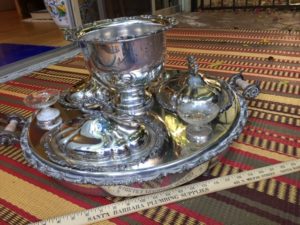 RT sent me a unique silverplate revolving round buffet supper server set, large at 18 inches high by 24 inches diameter. She asked: WHY did they call it a warmer?
RT sent me a unique silverplate revolving round buffet supper server set, large at 18 inches high by 24 inches diameter. She asked: WHY did they call it a warmer?
It kept food hot by means of a deep hollow lazy-susan water-well in which all the dishes sat. A spigot at the base served as drainage. It’s comprised of three covered oval servers for, perhaps, Welsh rarebit, bacon sandwiches, or creamed vegetables. and three master salt dishes of etched crystal. A central tureen may have came with a cover at one time for hot soup. Two wooden handles, massive, to the sides, made it easier for the servants to take it to the sideboard for a late night supper. It must have weighed a bit when filled with scalding water.
The type of silver plate is English Sheffield, a unique type of silver plate, in that the base-metal on all things produced in Sheffield at this time was, in a great degree, copper. The sheen of reddish golden glowed through the silver plating. The round form is accented by a scrolled boarder, stylistically putting it in the mid to late 19th century.
Why They Needed Warmers
Those who afforded a warmer owned houses large enough to eat or entertain in room far from the kitchen, sometimes downstairs or in another part of the property altogether. Warmers made the dining experience more private because hot water in a vessel made it so you didn’t need waitstaff to attend the meal. Also the style in which some families became occasioned to eat. Breakfast, for example, often appeared as a buffet set upon the sideboard. When you woke up, you wandered down and opened the lids, and partook. Similarly late night suppers usually occurred after the servants went to bed, and the family enjoyed it well into the night, especially after a ball or card party.
Remember many of the homes of note in England and on the East Coast of the US sat ‘bleeding COLD’ for a good half of the year. So hot food became hard to come by, unless the dishes either came insulated or warmed with a hot water reservoir.
The masses of warmers in the late 19th century grand house became legendary. To mention a few objects made to keep your food warm at breakfast:
- egg warmer, a little silver or silver plate egg shaped ovoid form on a stand
- tea server, an urn form with silver or base metal warmer frame inside a ‘biggin,” a coffee pot in silver or plate on a stand with a burner or candle feature beneath
- unique muffin warmer, a clamshell device to keep your muffin cozy
- bacon warmer, a flat round deep boat with a hot water reservoir beneath
- BIG breakfast warmer for the whole enchilada
- bun warmer, a dome of protection for your ‘buns’
One or many of these got sent up to your room by the maids on a tray or placed on the sideboard downstairs in the dining room.
Many Other Kinds of Warmers
If you ate a formal dinner with a soup course, at the table sat a spoon warmer, a small canister with an underlying reservoir of hot water to warm JUST your spoon. If you entertained a small party and the staff went to sleep, you took your plate from a round, vertical silverplate plate warmer with a small burner beneath. Vegetable warmers came in two forms. One for the vegetables that dripped water, like asparagus, and an oval one with a top cover that mechanically “sank” into the base for the creamed vegetables. The serving dish might also come with a warmer base of hot water for the main course.
Let’s say you felt sleepy after all that hot food. You retired with a small silver plate rectangular box with a few coals or hot water; your foot warmer. If you, as many ladies did, slept with gloves or mittens, a you also carried small silver plate mitten warmer.
I’d love to find one collector who collected warmers, but I doubt I’ll find her in California. If you DO, contact me. This is a fascinating area of cultural history. The value of the revolving silver plate buffet supper service set is $2,000.